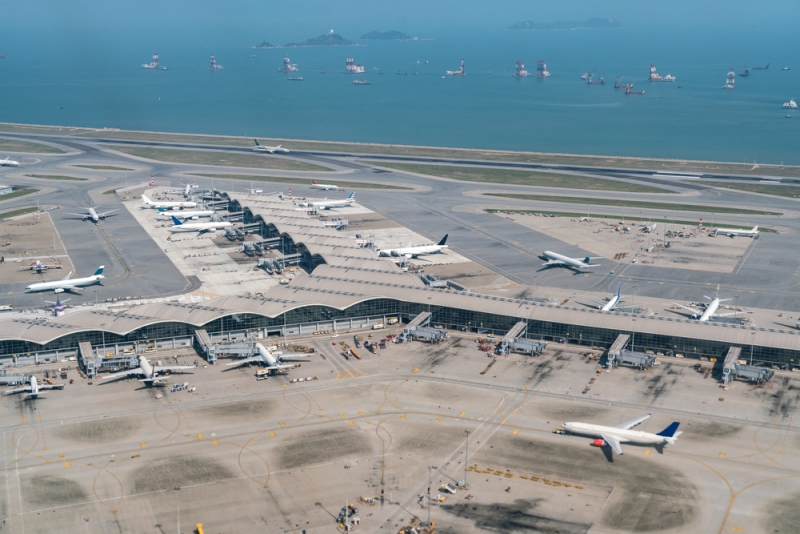Hong Kong International invests in cargo
06 / 09 / 2023

Source: Shutterstock
Hong Kong International Airport maintained its position as the world’s largest cargo hub in 2022 despite registering a double-digit percentage volume decline. The airport is now investing in further growth.
Last year, Hong Kong International Airport (HKIA) was ranked as the world’s busiest air cargo hub, despite its volumes falling by 16.5% to 4.2m tonnes.
The fall was the third largest amongst the world’s leading 20 cargo hubs – Shanghai PVG and Dubai DXB were the only ones to report bigger drops – as Covid restrictions on travellers and workers limited airline operations.
Wilson Kwong, the chief executive of Hong Kong cargo handler Hactl, says the decline was also a reflection of developments in the wider world; high interest rates, the high cost of energy and the impact of the conflict in Ukraine.
He says HKIA was also affected by a ban on the transhipment of e-cigarettes, although legislative amendments are being introduced that have allowed the export of vaping products to restart.
Cargo volumes have continued to fall this year – although at a much lower rate – as the industry has continued to struggle, but the airport is busy investing for the future.
Airport Authority Hong Kong (AAHK) assistant general manager of aviation logistics Irene Lau tells Air Cargo News that investments in airport infrastructure focus on the premium cargo and e-commerce segments.
She says a huge new 380,000 sq m logistics centre is currently being built for Cainiao – the logistics arm of e-commerce giant Alibaba – in the south cargo precinct and will become the third largest warehouse in Hong Kong when it opens.

Irene Lau. Source: AAHK
“The first and second largest [warehouses in Hong Kong] concentrate on seafreight, airfreight seldom has a warehouse of this size,” Lau says.
Meanwhile, earlier this year, DHL Express opened a HK$2.9bn expansion of its central Asia hub at the airport in response to growing volumes.
The expanded hub will be equipped with an enhanced material handling system and will be able to handle 125,000 pieces per hour compared with the current 75,000 pieces per hour.
When handling at full capacity, the annual throughput of the expanded hub is expected to go up by 50% to 1.06m tonnes per annum.
Lau adds that a new mail transit centre is being developed with Hong Kong Post and China Post, which will focus on cross-border mail and e-commerce fulfilment between China and the rest of the world.
The facility measures around 120,000 sq m and is expected to open in 2023.
Premium products
Lau says the airport is also focussing on premium cargo such as pharma, perishables, fresh, live animals and high-value cargo.
“All of these are very important to us. Even though in terms of volume they may not be very substantial, in terms of the value they have, they bring a very high contribution to Hong Kong and to external global trade,” says Lau.
She says that the airport has worked to achieve CEIV certification for both pharma and live animals to ensure a high standard of operation for goods moving through the airport.
Elsewhere, the airport offers airside cool dollies, cold rooms and apron shelter to support the movement of temperature-sensitive goods.
Connecting the dots
The airport is also taking aim at improving connectivity with mainland China as 75% of cargo originating in the Greater Bay Area is transported through Hong Kong.
To support this traffic, the airport recently announced the HKIA Logistics Park pilot scheme in Dongguan where shipments can be security screened, built up and accepted as cargo before being transported by ship directly to a quay at the airport and loaded onto waiting aircraft.
“Normally the goods from South China take the cross-border truck and then pass through customs in Hong Kong and China to our airport terminals and then they do the cargo acceptance,” says Lau.
“Now we have extended the terminal acceptance operations and even the freight forwarder cargo handling operations, like screening, consolidations, into China.”
Lau says that using the logistics park is 50% faster and around one-third of the cost of trucking from South China to Hong Kong.
Asked what the benefits of the scheme are compared with using airports in South China, such as Shenzhen and Guangzhou, Lau explains: “I think in terms of our connectivity, it is very much better than other airports at this point in time – we are truly a global hub.
“Our efficiency is high and our terminal operations can handle the cargo acceptance cut-off within three hours before departure of the flight – this is something that is very attractive to freight forwarders and shippers.”
Lau says that the airport has flights to 160 destinations worldwide and 40 destinations in China.

Wilson Kwong. Source: Hactl
Hactl’s Kwong adds: “It is also the expertise we have in Hong Kong. We have decades of experience in handling all kinds of cargo. Handling cargo in a reliable manner that is safe and secure and with top-notch customer service.
“It is an additional channel for shippers and forwarders to consider. This is part and parcel of the airport’s initiative, to enlarge its catchment area and provide better service and better alternatives for the shippers.”
The airport authority has also recently launched a data platform to connect air cargo community stakeholders.
“Not only the cargo terminal, airlines or regulators, but also extend our reach to the freight forwarders, warehouse operators and truckers,” says Lau.
“To start with we want to digitalise the current local process to make it more streamlined, efficient and paperless.
“In the long run, we also want to make use of the data insights and drive some sustainability initiatives to create more value for the users of our Hong Kong community.”
One of the biggest developments at the airport over the past few years has been the addition of a third runway.
Wilson explains that while operations began on the third runway in July last year, the airport continues to operate with two for now.
“The third runway is already constructed and in use but the second one, the centre one, is actually closed for maintenance at the moment.
“That is why the fully-fledged three-runway system will be operational next year.”
Wilson says that when the third runway system is fully operational the airport will increase its aircraft movements per hour from 68 to 102.
Hong Kong forwarders welcome move to lift “seriously detrimental” e-cigarette ban














